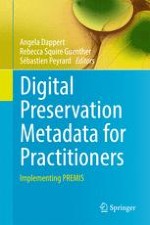2016 | OriginalPaper | Chapter
Implementing Rights Metadata for Digital Preservation
Author : Evelyn McLellan
Published in: Digital Preservation Metadata for Practitioners
Publisher: Springer International Publishing
Activate our intelligent search to find suitable subject content or patents.
Select sections of text to find matching patents with Artificial Intelligence. powered by
Select sections of text to find additional relevant content using AI-assisted search. powered by
When repositories acquire and preserve digital objects, certain types of metadata are automatically generated by systems and software while others are added by users. Technical information about file formats or standard outputs resulting from preservation actions is typically machine-generated; descriptive or cataloguing information, information about archival processes such as accessioning and appraisal, and information about intellectual property and other types of rights must usually be created at some point by the user and entered into software tools via data entry templates or other means. Repositories use different types of metadata for different purposes: for example, file format metadata can be used to assess format obsolescence risk and select preservation plans; descriptive information can be exposed in online access systems for discovery and citation purposes; and information about rights can be used as the basis for understanding the range of actions that can be taken by repositories with respect to the digital objects they have acquired. Rights can be a complex area for preservation repositories. Copyright and other statute-based restrictions, restrictions imposed by licenses or donors, and restrictions derived from institutional policies can sometimes overlap and compete with one another. Metadata standards for capturing rights information need to be flexible enough for preservation repositories to record rights data in ways that best meet their needs, and software tools implementing those standards need to support this type of flexibility. However, the data still need to be standardized enough to support a common and consistent understanding of what the information means. Moreover, rights information should be understandable to both human readers and software systems, which may be called upon to automate certain processes based on restrictions or permissions associated with digital objects. This chapter provides an overview of the PREMIS rights entity and how it is implemented in Archivematica, a digital preservation software system, in a way that attempts to allow repositories to address these complex requirements.
